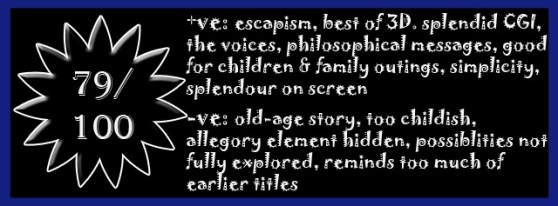This one brings back the memories of The Flintstones and Prehistorik, the first one being one of the most watched cartoons of that long lost childhood while the second one was among the first computer games I ever played – still, surely not the first ever. Both of them can be thus said to belong to my pre-historicism. Even as they could be categorized into the same category as cavemen, based on those ideas which originate out of assumptions about something which would never be known as how it exactly used to be, one could dare to say that this one is different – as a story of a predecessor of the modern family and as what came before what was to follow in a world of chaos, disorder and confusion which was not caused by the humans at that time; but now, as the nature has no need to cause the same as humans have themselves become the cause; this story is nothing less than an adventure rooted on more than one philosophy, and a tale of prehistoric truths belonging more to this age than any other, thus creating that connection which the audience could decipher in a three dimensional world of the theatre. They are no longer the stock characters, but the audience are – with their thoughts about specific individuals having certain ways of doing things, and what they are creates that infernal stereotype.
This movie was actually troubled by the large number of trailers which they showed right before the movie, and the interesting fact is that none of them were of English movies; for they were Hindi and Malayalam, and I shall not be depressed and say that they made no impact either, as I might just watch a few of those movies whose trailers were shown – something about which I can be sure as long as those Hindi movies are concerned and about the Malayalam movies, there would be more uncertainty surrounding them. But this long a trailer show was a first time experience for me, and I shall surely be ready to face such a thing from the next time onwards. But the positive impact is that the interval time had no advertisements, and still never did it impress me as the time taken for the second half to being again was long enough. To be frank, this not a movie which deserves an interval – it is quite short and continuous, and there is no loss of flow as it goes on like a river during the monsoon; full and powerful. It could have never inspired an interval with its length, but as we are so much used to having the first half and the second half, it is quite natural to be upset without a break in the centre and therefore it is justified.
The way in which the early prehistoric humans might have looked and behaved has been pretty much similar in most of the depictions in many ways. Their association with caves and pre-historic creatures have been commonly shown. This movie is about a family of Neanderthals who keep themselves confined to a cave as much as possible so that they could be safe from the outside world of predators. They are actually the last of the families out there to survive, as the others have already fallen victim to the creatures of the world as well as the deadly diseases of the age like common cold. Their survival can be attributed mostly due to the strict rules of the overprotective father and leader, Grug. Eep is the cavegirl, his daughter and the protagonist who forms the centre of the movie. The rest of the family includes Grug’s wife Ugga, his daughter Sandy, his son Thunk, and also his mother-in-law whom he always wished dead – the disapproval is more of a two-way procedure than anything else. He keeps telling his family that all the new things are bad, and so is the outside world which is extremely dangerous and they should keep themselves to a cave to survive. Considering the end of their neighouring families, he might be justified by most of his family members.
But this shall not be accepted by all, as this irritates the bored and highly adventurous young cavelady known by the name Eep as she keeps looking for an opportunity to do something new and find new things, and when the family falls asleep after dark, she ignores her father’s advice and runs out of the cave when she sees a light moving outside the cave making her feel that the sun has come down. She might have been troubled just as the Greek hero and adventurer Ulysses or Odysseus, just as Lord Alfred Tennyson had mentioned, it little profits an idle king, and same should be the case of a cavegirl. She cannot rest from travel either, and even with an experience which is an absoulute zero, she has decided “To strive, to seek, to find, and not to yield”, and travel beyond the horizons to the end of the world. She is the pathfinder, lightseeker and the follower of the sun, even as they never worshipped the forces of nature. The situation of herself and her family is later described as “not dying” rather than living, by herself. But the other members of the family have been quite happy with that stuff about not dying, the only person with a slight doubt might be the oldes of them all, Eep’s grandmother.
Seeking the source of light which is synonymous to the sun for her, she meets Guy, an intelligent caveboy who doesn’t live in a cave, and neither does he believe in finding such a dark shelter without light. She is incredibly fascinated with the fire he manages to create and is eager to find more, and even own some fire as her own. He tells her about his new finding that the world is going to end, with earthquakes, volcanic erruptions and other not-so-good things and asks her to join him in his journey towards safety where they could survive. She refuses as she thinks about her family and Guy leaves, after giving her a loud noise-making shell to call him if she ever feels the need for help in a world of natural destruction and chaos. Grug, who had been desperately searching for her, finally finds the young lady and brings her back home, and what she tells them about the end of the end of the world is not believed by them due to the fear of the other and the new. But in a few minutes, an earthquake then occurs, leading to everyone running for the cave, only to be saved by Grug moments before their home and the cave is destroyed by huge falling rocks. When they climb over all the destruction, they discover a land with new types of vegetation, lots of colours and greenery, much different from their usual surroundings of rocky and desert-like terrain with no variety.
Grug is forced to take his family into this comparitively darker, but beautiful woods to find a new cave for them to be safe from the new dangers. While becoming aware of the strange world which surrounded them, the family are chased by a big saber-toothed cat and also by a swarm of red, piranha-like birds who act more like insects than good little flying creatures despite of their cuteness. Finding no solution to a possible question of death, Eep uses a bone from an unknown creature to sound a horn similar to that which Guy gave her. Guy is actually quite close to them and runs to them, creates a torch of fire, and scares the birds away at the very last moment. The rest of the family are incredibly impressed by the fire, having never such a light-giving, heat-giving and life-saving thing before, that they almost set fire to the forest playing around with it. After feeling impressed with Guy’s intelligence, or more of his usefulness in a strange world of unpredictable horror, they decides to use his ideas to save them from possible end. Grug puts him locked in a hollow log and carries him, as they travel to a cave of a nearby mountain mentioned by Guy as their final destination where they could be safe. Remember Ice Age: Continental Drift – for it is the same division of the landmasses that is happening in the background.
It is this journey towards the expected salvation that they undertake together, and even as Guy and the family finds themselves separate from each other in many ways, they co-exist and help each other in moving towards a world which is no less than what is undertaken in The Pilgrim’s Progress by Christian in a work which centres itself in his journey from his hometown, the “City of Destruction” (this temporary world filled with devastation), to the “Celestial City” (the world that which is to come a.k.a Heaven) on the top of Mt. Zion. The Guy is the Evangelist, the Interpretor, the Faithful as well as the Hopeful – they are all inserted into one, for his faith is his ideas and intellect, and his hope is his belief in himself as well as in something which is far beyond his comprehension, that is the light or the word of God. But such an interpretation is not easily comprehensible as the movie is not perfected enough in such a way. If the movie’s childishness was lessened without affecting the funny moments or the philosophy, the movie might have been a perfect depiction of a wonderful journey, and a flawless allegory of this world and world which preceeded. But for now, lets enjoy the movie with all its fun and its effective 3D elements without any expectation to tickle the logic, but still staring at the easily visible message of mutual understanding and co-existence, exploration & knowing & accepting the world for all that it is.
Release date: 19th April 2013 (India); 22nd March 2013 (United States)
Running time: 98 minutes
Directed by: Kirk DeMicco & Chris Sanders
Starring (voice): Nicolas Cage, Emma Stone, Ryan Reynolds, Catherine Keener, Clark Duke, Cloris Leachman
@ Cemetery Watch
✠The Vampire Bat.



